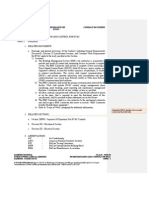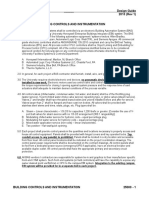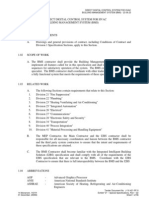H20
H20
Uploaded by
m.k.rameshkumar1Copyright:
Available Formats
H20
H20
Uploaded by
m.k.rameshkumar1Copyright
Available Formats
Share this document
Did you find this document useful?
Is this content inappropriate?
Copyright:
Available Formats
H20
H20
Uploaded by
m.k.rameshkumar1Copyright:
Available Formats
11/1/24, 7:57 PM Online PDF Translator | Translate PDFs to any language for free
— 188 — 60730-1 0 IEC:2013
b) short circuit of the impedance components that are likely to be missing due to a co-circuit (in
accordance with clause H.27),
c) the application of a fault condition according to clause H.27 to any part of the circuit that may
have the maximum leakage current with the protective impedance intact.
Also, the operation of a protection device or the loss of a supply point will be considered as defects.
In these conditions, the equipment will continue to comply with the requirements of H.8.1.10.
Additional subclauses:
H.11.4.16 The action of type 1. Yo 2. Y will function to provide electronic disconnection.
Compliance is verified through the tests of H.11.4.16.
H.11.4.16.1 The test is carried out with the control connected to its maximum declared load, with
nominal voltage, and at temperature 7 a x i m o.
H.11.4.16.2 The current through the electronic disconnection shall not exceed 5 mA or 10% of the
nominal current, whichever is less.
Controls that use software must be constructed so that the software does not affect compliance
with the requirements of this standard.
Compliance is verified through the electronic control tests in this standard, in accordance with the
requirements of H.11.12 and through the examination of the required documentation in
requirements 66 to 72, including Table 1.
The subclauses H.11.12.1 to H.11.12.4 inclusive are only applicable to control functions of software
class B or class C.
Subclause H.11.12.4 contains additional requirements for remotely operated control functions.
H.11.12.1.1 Control functions with software classes B or C will use measures for software, as
detailed in H.11.12.1.2 to H.11.12.3 inclusive, to avoid failures related to software in safety-related
data and related segments.
H.11.12.1.2 Structure for control functions with software class B or C
H.11.12.1.2.1 Control functions with software class C will have one of the following structures:
— single channel with self-test and periodic monitoring (H.2.16.7);
— double channel (homogeneous) with comparison (H.2.16.3);
— double channel (diverse) with comparison (H.2.16.2).
https://smallpdf.com/translate-pdf#r=translate 1/1
You might also like
- CSA C22 2 No 14 Rev 3 1 2018 ED 4 11 2023Document8 pagesCSA C22 2 No 14 Rev 3 1 2018 ED 4 11 2023Karina Elizabeth AyalaNo ratings yet
- Iec 61000-3-12Document12 pagesIec 61000-3-12Anil Kumar DavuNo ratings yet
- Substation Automation Systems: Design and ImplementationFrom EverandSubstation Automation Systems: Design and ImplementationRating: 4.5 out of 5 stars4.5/5 (3)
- White Paper Rouse 2h Sil Verification For Rosemount Type B Transmitters With Type A Components DataDocument16 pagesWhite Paper Rouse 2h Sil Verification For Rosemount Type B Transmitters With Type A Components DataCARLOS PEREZNo ratings yet
- 01815-HVAC Comm ReqsDocument8 pages01815-HVAC Comm ReqspablogoncNo ratings yet
- H16Document1 pageH16m.k.rameshkumar1No ratings yet
- Control of Class B Control FunctionsDocument2 pagesControl of Class B Control Functionsm.k.rameshkumar1No ratings yet
- Annex H (Normative) Requirements For Electronic ControlsDocument2 pagesAnnex H (Normative) Requirements For Electronic Controlsm.k.rameshkumar1No ratings yet
- UL 873 12th Ed 16 Nov 2007 ED 8 31 2019Document4 pagesUL 873 12th Ed 16 Nov 2007 ED 8 31 2019Aritra DasguptaNo ratings yet
- DM 101.00 Smx04000pjr CommentsDocument119 pagesDM 101.00 Smx04000pjr CommentsVera BotvinnikNo ratings yet
- FL - Hvac Instrumentation and ControlsDocument30 pagesFL - Hvac Instrumentation and Controlscytech6619No ratings yet
- Protection Against Electric ShocksDocument1 pageProtection Against Electric Shocksm.k.rameshkumar1No ratings yet
- UL 60730 1 Rev 5 21 2014 and 8 3 2016 ED 10 19 2018Document12 pagesUL 60730 1 Rev 5 21 2014 and 8 3 2016 ED 10 19 2018sharilNo ratings yet
- H21Document1 pageH21m.k.rameshkumar1No ratings yet
- 11kV Outdoor Switchgear PDFDocument48 pages11kV Outdoor Switchgear PDFMekonnen ShewaregaNo ratings yet
- Building Automation System (BAS) For HVACDocument20 pagesBuilding Automation System (BAS) For HVACari_aristaNo ratings yet
- Therapy Palo: SECTION 23 09 23 Direct-Digital Control System For Hvac Part 1 - General 1.1 DescriptionDocument49 pagesTherapy Palo: SECTION 23 09 23 Direct-Digital Control System For Hvac Part 1 - General 1.1 Descriptionee.avpindustriesincNo ratings yet
- H4Document1 pageH4m.k.rameshkumar1No ratings yet
- LV Board SpecsDocument21 pagesLV Board SpecsVignesh BalakrishnanNo ratings yet
- Freely Inspired Framework From Od-2045 - Ed.2.0: About The IECDocument12 pagesFreely Inspired Framework From Od-2045 - Ed.2.0: About The IECMathilde BéalNo ratings yet
- Attitude IndicatorDocument7 pagesAttitude IndicatorlucsNo ratings yet
- Rowan - Controls - Standards - JZ Rev 1Document7 pagesRowan - Controls - Standards - JZ Rev 1zeliteNo ratings yet
- Form 6 Pole Mount Recloser Control Specification Ps280005enDocument12 pagesForm 6 Pole Mount Recloser Control Specification Ps280005enLuis Francisco Calderon EspinozaNo ratings yet
- IEC 61000-3-2 Harmonics Standards Overview: Corporate Headquarters Nordstrasse 11 CH-4542 Luterbach SwitzerlandDocument5 pagesIEC 61000-3-2 Harmonics Standards Overview: Corporate Headquarters Nordstrasse 11 CH-4542 Luterbach SwitzerlandDinh Le TuanNo ratings yet
- Dam InstrumentationDocument9 pagesDam InstrumentationDheeraj ThakurNo ratings yet
- Direct Digital Control For HVAC (BMS)Document56 pagesDirect Digital Control For HVAC (BMS)Humaid Shaikh100% (4)
- 110 26Document9 pages110 26Armin Fernández GerardoNo ratings yet
- Info Iec61000-3-11 (Ed1.0) en DDocument8 pagesInfo Iec61000-3-11 (Ed1.0) en DSabir NaseerNo ratings yet
- F3528 15900AddendumAttach4Document14 pagesF3528 15900AddendumAttach4Divakar Pullam ChettiNo ratings yet
- Patriot LPV SpecDocument4 pagesPatriot LPV SpecFederico Pérez de LeónNo ratings yet
- Technicala RequirementsDocument31 pagesTechnicala RequirementssrawanmeNo ratings yet
- Transformer TestingDocument33 pagesTransformer TestingUsman Saeed0% (1)
- EU TWN High Voltage Electrical Equipment Management ForumDocument27 pagesEU TWN High Voltage Electrical Equipment Management ForumŽarko MočnikNo ratings yet
- Performance Comparison of A Permissive Overreach Transfer Trip (PDocument102 pagesPerformance Comparison of A Permissive Overreach Transfer Trip (PLavan KumarNo ratings yet
- 23 09 00honDocument23 pages23 09 00honganesh2428364No ratings yet
- AC Circuit Breakers Routine Tests According To IEC 62271-100Document12 pagesAC Circuit Breakers Routine Tests According To IEC 62271-100sathishkannanNo ratings yet
- Aec Q101-004Document7 pagesAec Q101-004mathurashwaniNo ratings yet
- Type Ests Yo Aboratory Pe I 2002-0 Ype NG, Ation The Test ShallDocument1 pageType Ests Yo Aboratory Pe I 2002-0 Ype NG, Ation The Test ShallsubasratnaNo ratings yet
- Vector March2013 NewDocument4 pagesVector March2013 NewSameerEkriemNo ratings yet
- Section - Vii: Technical Specifications: 33 KV VCBDocument4 pagesSection - Vii: Technical Specifications: 33 KV VCBSundaresan SabanayagamNo ratings yet
- Anexo R ENDocument14 pagesAnexo R ENgabriel.goulart21No ratings yet
- Instrumentation and ControlsDocument22 pagesInstrumentation and ControlsIbrahim Abdel-khalekNo ratings yet
- 3466 - Revised Solar PV Checklist - June 2017Document8 pages3466 - Revised Solar PV Checklist - June 2017Electricité & Instrumentation Gassi TouilNo ratings yet
- KISI - Section 28 Access Control SpecsDocument8 pagesKISI - Section 28 Access Control SpecsNorm LanumNo ratings yet
- Honeywell Building Management SystemDocument26 pagesHoneywell Building Management SystemDuy Phạm Văn100% (4)
- Section 230913 - Instrumentation and Control Devices For HvacDocument9 pagesSection 230913 - Instrumentation and Control Devices For HvacgolfnunoNo ratings yet
- PruebaDocument65 pagesPruebaGhelber RamirezNo ratings yet
- 33 KV Control Relay Spec PDFDocument75 pages33 KV Control Relay Spec PDFMohanta Amrit100% (2)
- T. in The Case of Current-Limiting Fuses, The Maximum Arc Energy May Occur at Current LevelsDocument20 pagesT. in The Case of Current-Limiting Fuses, The Maximum Arc Energy May Occur at Current Levelsnandana_849065438No ratings yet
- 26 23 00 - Low-Voltage Switchgear Guide SpecificationDocument21 pages26 23 00 - Low-Voltage Switchgear Guide SpecificationdexterNo ratings yet
- United Electric Controls CertificateDocument2 pagesUnited Electric Controls CertificateAmet koko TaroNo ratings yet
- Design and Analysis of Dynamic Voltage Restorer For Deep Voltage Sag and Harmonic CompensationDocument14 pagesDesign and Analysis of Dynamic Voltage Restorer For Deep Voltage Sag and Harmonic CompensationJoffie Jacob PulpelNo ratings yet
- Information Model For Power ExchangeDocument39 pagesInformation Model For Power ExchangeGanesh NagarajaNo ratings yet
- Fa 11259Document20 pagesFa 11259K.RamachandranNo ratings yet
- Substationsfinal2013 PDFDocument137 pagesSubstationsfinal2013 PDFManoj RanaNo ratings yet
- New Definition in Section 2 of The Principal CodeDocument6 pagesNew Definition in Section 2 of The Principal CodePrasenjit DeyNo ratings yet
- HVAC Instrumentation and ControlsDocument16 pagesHVAC Instrumentation and ControlskktayNo ratings yet
- PSSDM 1Document5 pagesPSSDM 1MadhankumarNo ratings yet
- The Internet of Things: Key Applications and ProtocolsFrom EverandThe Internet of Things: Key Applications and ProtocolsRating: 5 out of 5 stars5/5 (1)
- H27Document1 pageH27m.k.rameshkumar1No ratings yet
- H23Document1 pageH23m.k.rameshkumar1No ratings yet
- H15Document1 pageH15m.k.rameshkumar1No ratings yet
- CAN Transfer ProtocolDocument28 pagesCAN Transfer Protocolm.k.rameshkumar1No ratings yet
- Scheme SPV Water PumpsDocument13 pagesScheme SPV Water Pumpsm.k.rameshkumar1No ratings yet
- EoI Solar Water Pump ManufacturesDocument4 pagesEoI Solar Water Pump Manufacturesm.k.rameshkumar1No ratings yet
- Atmel AVR 8-Bit Toolchain 3.5.4 - Release NoteDocument11 pagesAtmel AVR 8-Bit Toolchain 3.5.4 - Release Notem.k.rameshkumar1No ratings yet
- CapacitorsDocument5 pagesCapacitorsm.k.rameshkumar1No ratings yet



































































